Posts Tagged ‘famous Buchenwald photo’
Saturday, July 9th, 2016
BY CAROLYN YEAGER
copyright Carolyn Yeager 2016
Though they say a picture is worth a thousand words, these two need some explanation. One is from 1987, the other from 2006. Since the more recent one will arouse much more attention, I better start with that.
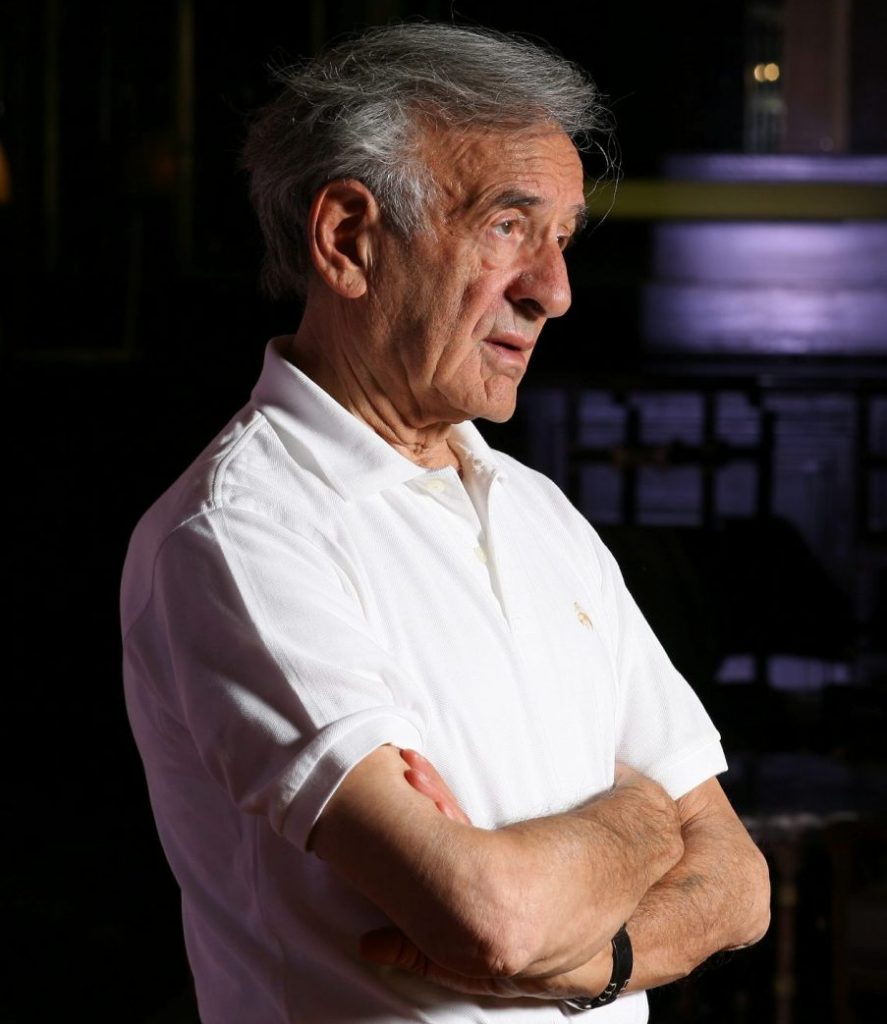
This 2006 photograph taken by Eyal Toueg, displayed in a July 9th “Premium” article by Shlomo Nakdimon at Haaretz, has been cropped by me to remove some of the dark space to the right … the better to see the important details. This may be the first time it has been published.
You will notice right away that there is a smudge on Wiesel’s left forearm, precisely where an Auschwitz tattoo would be. Many people will say, Oh, that’s his very, very faded and blurred tattoo. But it looks more like a bruise, and, by using your keyboard to enlarge the image while retaining a clear resolution, you’ll find, as I did, that it then looks even more like a bruise the larger you go. Plus there seems to be more bruise just above it where his right arm meets his left. [I’m speaking tongue-in-cheek here, and below. I don’t actually think it is a bruise, but all we can see, even highly enlarged, is a smudged blue area that looks like a bruise. So what are we to call it?]
[To enlarge the image, first click on it to get the full size image, then hold down the Ctrl key while clicking the plus (+) key as many times as you can or want. To bring it back to normal, do the same with the minus (-) key. Both keys are on the upper right next to “backspace”]
This photograph has to be from the same photo session that includes the one where he’s sitting with the oversize Hebrew book — he’s wearing the same white knit golf shirt and his hair is the same. That one has been used by Wiesel defenders to suggest there is a faint tattoo on his arm. You can see it here and here.
However, this kind of thing is the typical Wiesel mode of operation throughout his life. He refuses to be explicit about his person and his personal life, even though he gets very explicit about things like the “shades of wateriness of the soup” and the face of the boy he wrote was hanged in Auschwitz. But his own body–which can be checked–he offers not a word of description. And looking at this blue-black discoloration, I can see nothing—even with using all my imagination—that I could imagine to be a 7713. I know you can’t either, but you might try to come up with some theory about it. I have my own theory, that Wiesel pinched himself real hard the day before the photographer came.
In 2006 he was 77 years old, an age when it’s extremely easy to bruise the skin. And that’s what it looks like. Recall the tattoos of so many other inmates from his same time there — none look like this.
But I have a second theory, which might be better — that Wiesel had applied his own tattoo number with ink but he didn’t go deep enough. It was only applied to the dermis (outer layer of skin), not the epidermis, and so it disappeared over time as new skin cells grew until now it is just a smudge of dispersed ink. Remember the top photo on this page that doesn’t look like a real tattoo — this may be when he did it.
Now, the other picture indicts him even more. He is in Lyon, France for the Klaus Barbie show trial and stops by the Holocaust Memorial there on June 2, 1987. He just won the Nobel Peace Prize 6 months earlier, and this Buchenwald liberation photo was associated with him winning that prize. You recall right after the ceremony he traveled to Yad Vashem in Jerusalem and posed in front of a large blow-up of this very photograph.
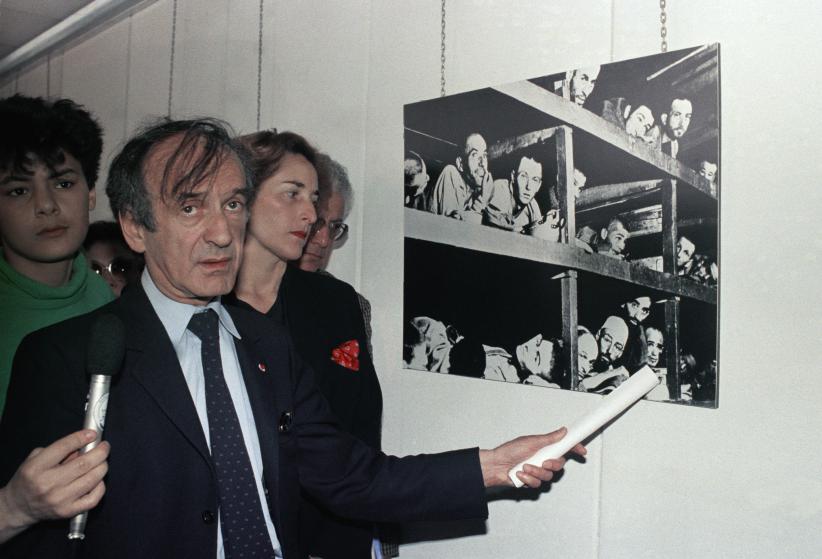
Elie Wiesel, winner of the 1986 Nobel Peace prize, visits the Holocaust Memorial in Lyon, France, June 2, 1987. The photo on the wall shows prisoners of the German Buchenwald concentration camp inside their barracks, five days after U.S troops took over the camp near Weimar, Germany. Wiesel points to himself in the picture. (AP Photo/Laurent Rebours)
Notice that Michael Grüner on the bottom row was cropped out of this version, along with the tall standing man, but there is Mel Mermelstein peeking out from the upper far right. Mel wrote a whole book about his incarceration before Wiesel said in 1983 that he was in this picture, but Mel never mentioned knowing the already famous Elie Wiesel there in his book! Mermelstein resided in the children’s barrack, too.
In this photograph, the unkempt Wiesel is sealing his doom by pointing directly to the unknown person (not him) he is claiming to be himself. And with such a guilty expression, too! Nothing could prove his dishonesty and forgery better than this.
I came upon this picture in the Time magazine Elie Wiesel photo collection posted at the time of his death. When I saw this one I quickly saved it. This might be my all-time favorite picture of the Wiesel. I will surely make more use of it.
23 Comments
Category Featured | Tags: Tags: Auschwitz tattoos, Elie Wiesel, famous Buchenwald photo,
Social Networks: Facebook, Twitter, Google Bookmarks, del.icio.us, StumbleUpon, Digg, Reddit, Posterous.
Sunday, April 17th, 2016
BY CAROLYN YEAGER
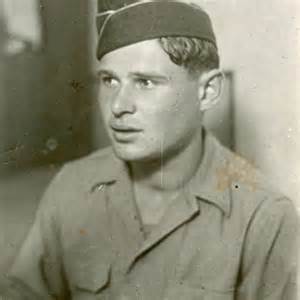
This is a picture of Paul Argiewicz used by the Wisconsin Veterans Museum but with no description. Considering he’s wearing a US Army cap it has to be from after 1950, which would make him over 25 years of age.
Remember Paul Argiewicz? He’s the guy I wrote about here because it’s widely claimed he’s in the Famous Buchenwald Liberation Photo, which he is not. But there are a lot of things wrong with the Paul Argiewicz story – claiming he is in that photo is just one of them.
Christine Miller has observed that being forced to believe holocaust survivor’s stories has made Western man irrational. Paul’s story is as irrational as any, especially when it comes to the simple act of adding together two-digit numbers. So let’s start there.
Paul’s date of birth is always given as Aug. 6, 1925 in Bielsko, Poland. He grew up using his mother’s name, Argiewicz, because his parents were not formally or officially married. The family included two older sisters. He told interviewers that he only went three and a half years to grade school. He was arrested in 1941 by his own reckoning, when he would have been 16 years old.
However, his story, wherever you look either online or in the book about him, states that he was age 11 at the time of his arrest by the Nazis, and in his own obituary written or approved by his family it says “he was arrested at age 10 by the SS for stealing bread for his starving family in the Jewish ghetto.” [The ‘stealing bread for starving family’ part is obviously fiction, but Paul was known as an emotional person who cried easily and liked to create as much sympathetic reaction in his listeners as possible.]
So what’s going on with this man? And with his family and biographer? Can’t they add? It’s apparent that holocaust survivors have become so complacent because of their experience that anything they say will pass that they actually believe “anything will pass.” Even to the point that if you’re born in 1925 you can be 11 years old in 1941. Think about it. The year of Paul’s arrest is not always mentioned as it is here, but we all know the camps were liberated in 1945, and we know he turned 20 in that year. Precisely, he was 19 on April 11, 1945, four months shy of his 20th birthday … not 14.
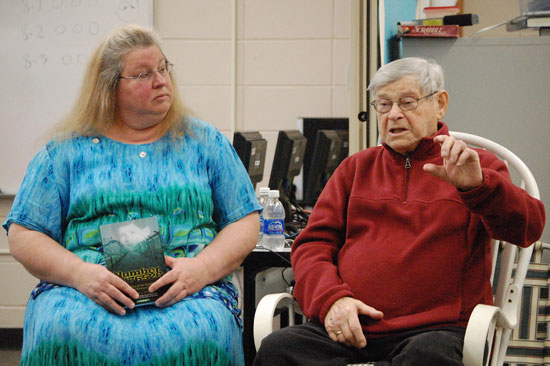
Deanne Joseph Ebner (left) who wrote the book “Number 176520: The Story of Paul Argiewicz ”A Teenage Holocaust Survivor” appeared with Argiewicz in 2012 at Riverview School.
What makes this age imposture important enough for Paul and his biographer to try to slip it past most readers? The craving for attention. Paul separates himself from the crowded field of fellow “survivors” by billing himself as a “child survivor.” He describes himself as being still a teenager when he was released … which he was, even if just barely. But he wanted to be younger still … a child. And what is surprising is that he basically has gotten away with it! I have not come across anyone questioning the claim that Paul was 11 when he was arrested, even though he was born in 1925. [I notice he told the Wisconsin Veterans Museum interviewer on page 7 that he was born in 1933!]
This type of “pass” can be better understood from a question by a poster commenting to another “survivor” who claimed he rode in a packed train car for 6 days with no food or water and no stops:
Did anyone die midway in the six day train ride with no food/water? I’m by no means doubting, just asking a question. As someone has mentioned below, you CAN survive without water for about a week.
God forbid these young people should doubt anything said by a holy survivor, no matter how unconnected to reality. The “survivor” answered he didn’t recall any deaths. But the point being, we don’t ask questions – we’re ashamed or afraid to question – and it leads to utter nonsense.
After doing more than a bit of research into Paul Argiewicz, I’ve come to the conclusion that there is also a felt need by him to gain as much sympathy as possible from being a tender 11 years of age to avoid what may be legitimate questions about what he actually did during that 4-5 years in German camps. I’m quite sure that Paul was never starved nor even mistreated during his time in the camps. He was more likely quite the collaborator. The photo on his German drivers license dated June 1946, only one year after liberation, shows a healthy young man with no sign of having endured any trauma whatsoever. He’s wearing an expensive leather jacket or coat and looks untroubled and at peace with himself.
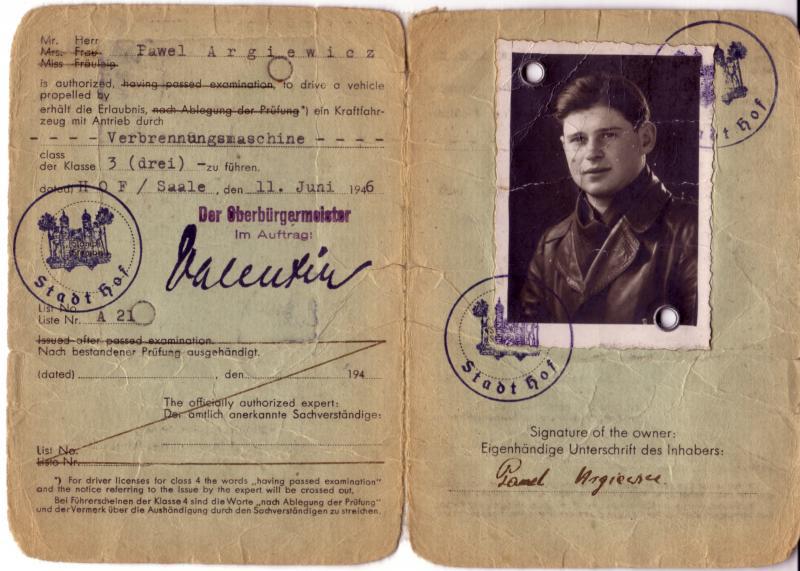
German Drivers License issued to Paul Angiewicz in June 1946. He was obviously living in Germany at the time and looking prosperous.
The same craving for attention also accounts for his willingness to falsely identify himself in the Famous Buchenwald Liberation Photo. Argiewicz named himself as the person 3rd from the left in the 3rd bunk up from the bottom in 2008, the same year his book came out. Everyone in that photo is self-identified, and it began after Elie Wiesel identified himself in it in 1983. Before that, no one was identified. After research by a number of people, including myself, it turns out the only correctly identified person is 16-year old Michael (Nikolaus) Grüner in the lower left. Even Argiewicz’ nephew, Murray Matzner, says his uncle is not in the picture, but excuses his uncle’s lies with the charge that he was under the influence of the woman who wrote the book about him, Deanne I. Joseph. Matzner wrote a comment at Scrapbookpages Blog in 2015 to a post that originally appeared in 2010.
It is obvious that my uncle Paul Argiewicz is not the person indicated in the photo. It looks nothing like him, and is in fact proved not to be him in his own memoir book photo on the opposite page where a drivers license photo one year later does not resemble this face at all. In particular, he did not have eyebrows that curved so far around his eyes.
The assertion that he is present in this photo was nonexistent until 2008, the year his memoir book was published. Since his ghost written book gets so very many facts and stories wrong, as the website associated with book sales also does, and stains a courageous man of integrity who is greatly missed because he is no longer with us, it appears that the false assertion is associated with the factually compromised book.
I have also seen a photo where it is the man one bunk lower, and to the left, a sleeping man facing away from the camera, who is indicated as my uncle with a vertical arrow.
I don’t know what it is with this photo. The individual indicated as Mr. Wiesel appears to have a receding hairline although a published image of him at age 15 prior to deportation does not have such a hairline. I believe that neither he or my uncle appear in the photo, and it appears to me that at least in the case of my uncle, that it was someone else pushing for him to be present.
My uncle was a wonderful, warm, caring, courageous, person who inspired so many with his exceptional love of life and people… but he isn’t in this photograph.
RIP, uncle. Your love lives on.
Comment by Murray Matzner — April 3, 2015 @ 1:03 pm
Okay Murray, except that Paul was photographed at one of his gatherings holding an enlargement of the famous photograph, indicating that he certainly wanted people to believe that he was in the picture. He, and maybe more so his wife Sheryl have been fully engaged in that fantasy.
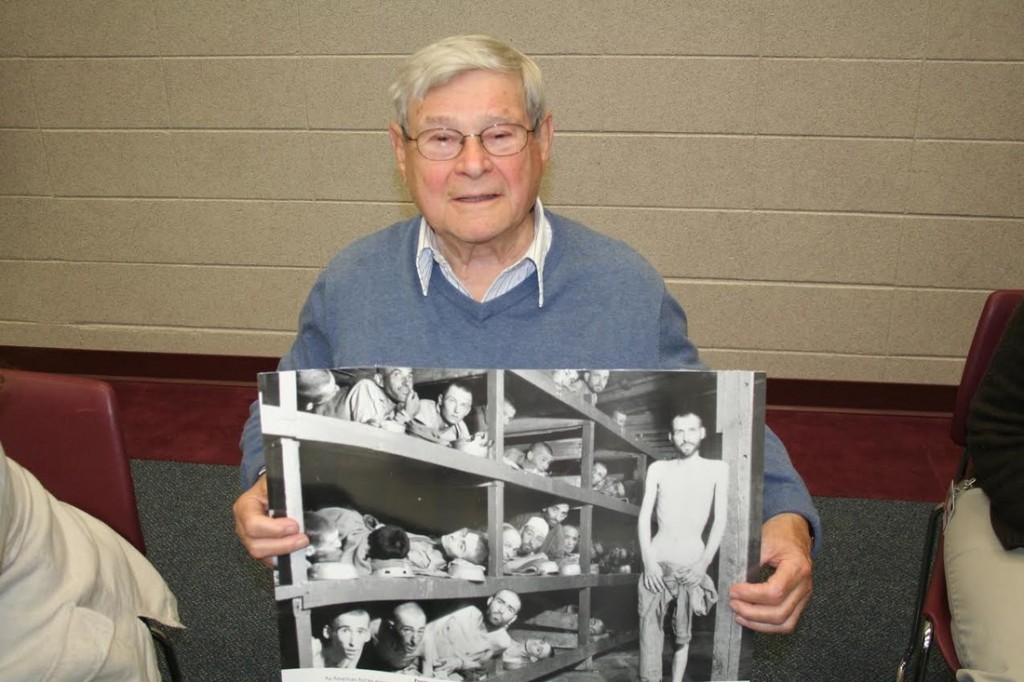
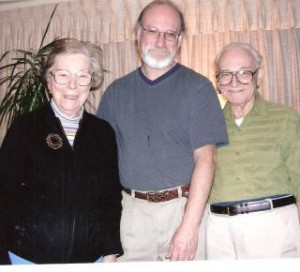
Lucy Argiewicz Matzner (Paul’s “beloved” sister), her son Murray and husband Robert.
Murray’s father, Robert Matzner, (left, in green shirt) who married Paul’s sister Lucy, was born in 1926 in the same Polish town of Bielsko. He has written his own holocaust memoir, titled Prisoner 19053. I wonder how many falsehoods that book contains? Hopefully not as many as Paul’s. But I think Murray may be trying to keep peace in the family by blaming the falsehoods in Paul’s book on the author. Clearly, Paul’s wife Sheryl had a lot to do with the writing of the book, and the three are often pictured attending book-promotion meetings together.
* * *
After Paul’s death in December 2013, some controversy broke out on the Amazon book advertisement page among the “reviewers.” Specifically “BTI” wrote:
In Memory of Paul
By BTI on June 22, 2015
Every story in this book is documented in numerous recordings, CDs, and videos as coming from Paul Argiewicz himself – his face, his words, his voice. It is Paul’s account of what happened to him as a young boy in the Nazi concentration camps. Anyone who knew Paul, loved Paul, was inspired by Paul, and truly desires to protect the memory of Paul Argiewicz will boldly stand witness against the frauds of the world (be they Holocaust deniers, anti-Semites, or vindictive relatives). All of the above-mentioned records of Paul’s testimony will soon be posted online. Be watching. May the evil ones be silenced by their own arrogance.
Cindy Nicoletti, Paul’s stepdaughter, posted a “review” by Dave Kasiske. In it he revealed:
“I am blown away that Paul’s nephew would come out now after Paul’s death. He cannot say the man in the picture is not Paul because the poor young Paul was probably close to death after experiencing starvation. Paul would say “Dave”, I can’t explain it to you how it was to cry at night because of starvation and never seeing my loved ones again.”
And
“Paul was always in tears when he told the story of his sister Lucy. Lucy is the mother of “Murray”, the one who is attacking Paul’s story. That brings the question to my mind, why would anyone who is Jewish go on a antisemitic spur? Even when I would sit with Paul at his kitchen table, the tears would flow when he talked about Lucy. Anyone who has the guts to attack a family member who survived the horrors of the Holocaust should seek psychological help.”
Yes, it takes guts indeed to stand up against holocaust lies, Dave. Maybe someday you’ll be able to do it. But now take a look at this from stepdaughter Cindy to see who is pushing Paul’s false story.
The owner of Sunless Expressions would like to recommend her stepfather’s book:
Number 176520
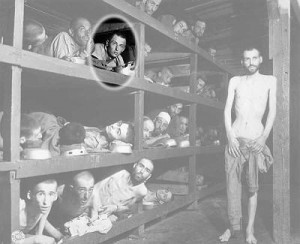
This famous photograph was taken a few days after the liberation of Buchenwald and appeared on the cover of a popular national magazine in the 1960s. Paul is pictured (circled) here on the third bunk from the bottom, the third person from the left (with his food bowl that doubled as a pillow).
Cindy, Owner and Founder of Sunless Expressions is the step daughter of a man with an astounding and miraculous life story. Paul Argiewicz was an eleven year old child in 1941 when he was arrested in Poland by two Nazi SS officers. His crime? Paul had stolen two loaves of bread to take to his starving family in the Jewish ghetto. Separated from his family and everything he loved, he would spend the next four years of his young life working as a slave laborer in seven different concentration camps. From Auschwitz to Blechhammer, Gross Rosen, and Buchenwald, Argiewicz; defied all odds by surviving one of modern history’s most unimaginable atrocities against humanity: the Holocaust.
Sunless Expressions is proud to recommend Number 176520 ~ The Story of Paul Argiewicz, a Teenage Holocaust Survivor. With over 16 pages of full-color photos, original camp documents, and other visuals, Number 176520 has quickly become a highly revered and sought-after Holocaust resource in schools, bookstores, libraries, museums, and homes. Visit www.paulsstory.com to purchase and/or learn more about the book that has been inspiring countless readers around the world.
We regretfully announce Paul passed away December 11, 2013.
Paul’s last public appearance before his death was on April 29, 2013 at the U.S. Holocaust Museum’s 20th Anniversary Ceremony with speakers Elie Wiesel and Bill Clinton. Here he is photographed with his wife Sheryl and grandson Jordan, who are active in furthering the mythical version of his life. In another photo he is showing off his Auschwitz tattoo “176520,” as they were all doing that night (except for Wiesel, of course). Yes, they were there, but what they did or did not experience cannot be proven by a tattoo.
There are no excerpts available from his book at Amazon, but I found this one and am going to quote it in full here. It gives a good idea of the fictional style found in most holocaust survivor stories – no dates, times, names – the events, as they are, exist as if floating in space, but are meant to evoke as much emotional sympathy, shock and pity as possible toward the subject. Notice the similarities to Elie Wiesel’s Night, which must have been used as a model, for example when the fellow arrestee advises a confused Paul to say he is 18. However, Paul’s “ghostwriter” handled the impossible jump from age 11 to age 18 by having the SS man play it as a sort of joke. And since Paul says he spoke perfect German, that warmed the heart of the otherwise cold officer. The whole scene is a lie …
At Scrapbookpages Blog, the blogger wrote in March 2010: “Argiewicz says that he had an advantage because he could speak fluent German since his mother was from Bavaria, a state in Germany.” Of course, we know his mother and father were both Polish, and Ms. Joseph comes up with a different story: That Paul associated with Gentile youths when he snuck out of the ghetto every other night for a year (!) and learned German that way. But weren’t there Poles along with Germans outside of the ghetto? This is not explained, of course, but left to your imagination. Apparently a German baker and his children just loved little Paul and gave him bread and German lessons too.
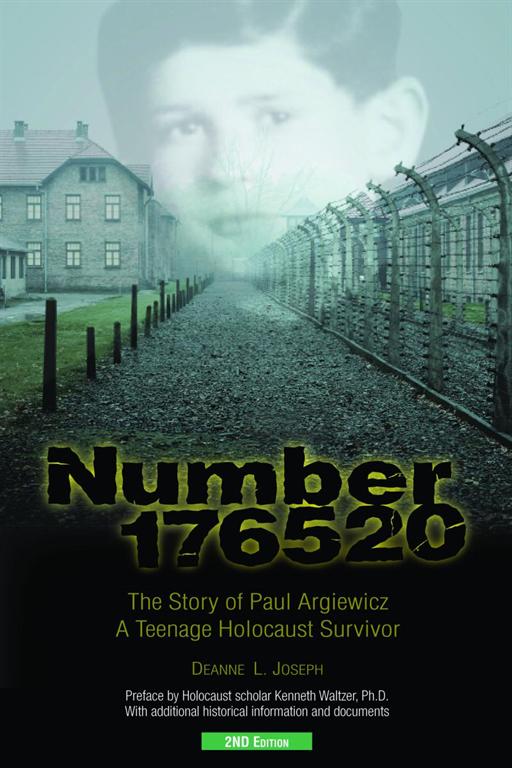
Look how dishonest the book cover is. Paul was not a young child in the camps but 16 to 19 years old. He wasn’t even in Auschwitz except for 2 days, then, according to him, sent to Blechhammer, and spent the last 4 months at Buchenwald.
The preface to the book is written by our old friend, Professor Kenneth Waltzer, and in it he gives “historical documentation.” I would really like to see that. I should order the book and write more about this later; the only thing that stops me is that you and I both know there is no end to this stuff. One thing leads to another. So we’ll see, but for now, enjoy this excerpt. You will notice that not a single person has a name except Paul.
* * *
Deanne L. Joseph’s moving new memoir, Number 176520 –The Story of Paul Argiewicz, a Teenage Holocaust Survivor, poignantly recounts one child’s journey through the terrors. With a preface and historical documentation provided by renowned Holocaust scholar, Professor Kenneth Waltzer (Director of Jewish Studies, Michigan State University), Number 176520 is quickly becoming an invaluable resource for students of the Holocaust.
Following is an excerpt from the book:
Paul and his family lived in the ghetto for about a year. In spite of the dire circumstances, his boyish, adventurous nature remained. He removed the identification patch from his clothing and sneaked out of the ghetto [Sosnowiec, not Warsaw -cy] through an opening in the barbed wire fence. It was an act of defiance that would have landed him at the end of an executioner’s gun had he been caught, but somehow he was able to pull off this rite two to three times a week. [I don’t think an 11-year old boy would be allowed out alone at night by his loving parents, do you? Neither would he have been shot dead if caught.-cy]
Being the gregarious child that he was, he made friends with some gentile children on the “outside.” They did not seem to mind that he was Jewish, and some of their parents even tried to help him in small ways. The father of one of his new friends owned a bakery. The man’s sympathetic conscience obliged him to turn a blind eye, allowing Paul to steal freshly baked bread from his store twice a week. The ritual continued for a year. Sometimes the determined young scavenger managed to find potato peels or other small provisions of vegetables and was always faithful to rush his smuggled goods back to his hungry family behind the fence.
Eventually, Paul became so comfortable in his excursions that he inadvertently lowered his guard and came face to face with disaster. Returning to his family with a pair of stolen loaves of bread, he was approached by two SS officers.
“Where did you get that bread?” they demanded. Paul had never been so close to the enemy. He stood, accused and frozen.
“Come with us!” The order was stern and curt. They snatched the bread from his hands. The pounding of his heart intensified until he thought it would surely break through his chest. He could barely breathe. He felt a hard, squeezing pressure on his arm — the grip of a Nazi. He had the sensation of walking very quickly, although he was unable to feel his legs. Were his feet touching the ground? Were they even moving? He heard only the sound of the officers’ boots clacking with each step on the hard street beneath their feet. His eyes burned as if on fire, and blurred images of his family flashed through his rattled brain. What would they think? Would he ever see them again? Were these men going to kill him? Paul fought to restrain the tears pooling in his eyes. He was only a child — his life was supposed to be ahead of him, not behind.
They arrived at their destination: an old schoolhouse that had been converted into a transitory evaluation and detainment center, the Durkankslager. He was taken downstairs to the basement, the “dungeon.” It was filled with people standing in lines. Everywhere were the familiar Jewish identification patches. The Nazis pushed him into place with the others. He looked around at the detainees, predominantly grown men. He did not see any other children in the crowded space.
An SS officer sat upright on a stool at the front of the room, one leg raised and bent at the knee with his booted foot confidently perched on a table. Behind him was a desk filled with papers. As each of the accused men made his way to the front of the line, he was questioned by the man on the stool, evaluated, and sent into a group either to the right or to the left. Paul was not sure why the men were being divided, but as he drew closer to the evaluating officer, he was overcome with a sense of doom. His mind fired rapid, disconnected thoughts. I’m only a child . . . perhaps if I tell them I’m only 11 years old . . . maybe they will have pity and let me go back to my parents.
Without warning, a man behind him in the line kicked the back of his leg. He leaned into Paul’s ear and spoke quietly but firmly.
“Don’t tell them your real age. Tell them you’re 18.”
How did he know what I was thinking? Paul wondered.
He arrived at the head of the line. No longer did anyone stand between him and the “judge.”
“Name?” “Paul Argiewicz.”“Age?” “Eighteen.”
The words rolled off his lips in perfect Bavarian German. The officer looked up. His dusky eyes examined the youth before him. His brow furrowed, and he observed the boy for a moment. Paul felt as though he had been suspended in space and time. The moment seemed to last an eternity. Surely, he was exposed . . . guilty . . . he had lied . . . to an SS officer! The penalty for such an offense was execution.
“You speak German?” The officer seemed amused. “Yes,” he responded once more in the language he had learned from his playmates.
“You speak with a Bavarian accent. Why?” “My mother is from Bavaria,” he lied again. For another endless moment, the man’s eyes pierced him. Paul was able to manage a convincing expression. Finally, the harshness of the Nazi’s sharply featured face faded, yielding to a smile and a chuckle.
“Go over there,” he said, nodding his head to his left.
Paul moved in the direction of the nod, but he did not understand the purpose of separating the men. Would he be sent to work or to the grave? None of the men seemed to know the fate that awaited them.
They remained in the detainment center for a few more days. Each day they were given small rations of bread and a cup of water. Paul allowed his mind to escape into a place of refuge and peace. He comforted himself with thoughts of his family, memories of good times they had shared, life in Phella’s beautiful home, and the hope that maybe he would soon be returning there.
In the corner of his eye, Paul perceived movement through a window in the damp stone wall. He turned his head to look through the dusty glass. Just beyond the tall barbed-wire fence, his father stood, his eyes scouring the room through the wire and glass. Noah’s eyes found Paul’s. His hand flew over his head waving to his son, his familiar penetrating eyes filled with longing. He held his hand still for a moment and then let it fall limp to his side. He stood motionless, his gaze fixed on his child. [This is a totally fictional account intended to create poignancy. Paul never saw his father through a window.]
Paul’s heart raced within him. An overwhelming urge demanded that he jump to his feet and run to the window. He dared not. To do so would jeopardize not only his fate but also now his father’s. Separated by brick and mortar, barbed wire and guns, and the merciless cruelty of the human heart, father and son looked upon each other for the last time. In that sacred moment, they knew that the bond they shared was beyond man’s reach; it was a bond protected and preserved in eternity. Still, the 11-year-old was overcome by the realization that he might never again feel the loving touch of his father’s strong hands or hear the sound of his voice.
On the cold, hard floor, Paul covered his face and wept. His father was gone. [End of excerpt]
5 Comments
Category Featured | Tags: Tags: Auschwitz tattoos, famous Buchenwald photo, Holocaust fraud, Ken Waltzer, Murray Matzner, USHMM,
Social Networks: Facebook, Twitter, Google Bookmarks, del.icio.us, StumbleUpon, Digg, Reddit, Posterous.
Sunday, December 23rd, 2012
By Carolyn Yeager
copyright 2012 carolyn yeager
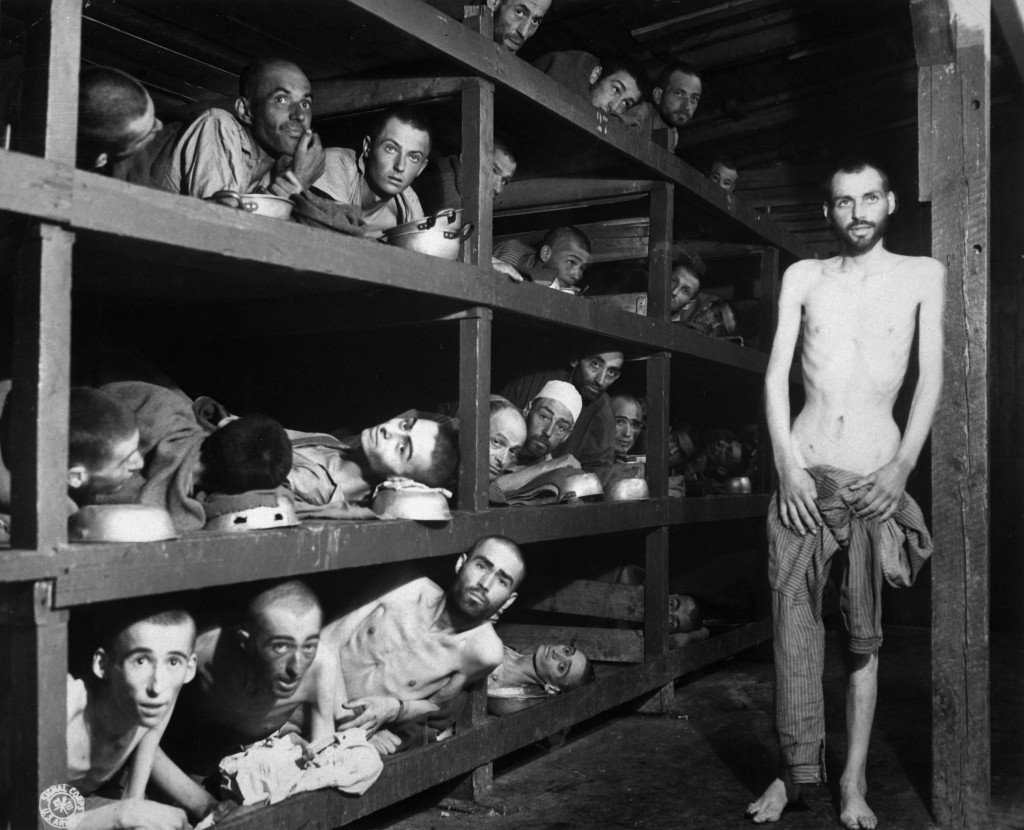
Do you remember the nursery rhyme that goes:
Sugar and Spice and all things nice, that’s what little girls are made of.
How about this one:
Magic and Trickery and all things fakery, that’s what “the holocaust” is made of.
This very famous image associated with the so-called “Holocaust” that was discussed in the previous post has turned out to be fraught with fakery. A sharp-eyed reader, Paul Borresen, noticed something that, once seen, makes one wonder how it was not seen before!
What he noticed is that, in addition to the forged standing man exposed in my previous post, one of the men in the bunks appears twice in this Famous Buchenwald Lie-beration Photo, and the similarity is unmistakeable.
Viewing the photo above, enlarged as much as it can be … find the young man lying on his back with head turned toward the photographer, in the 2nd row up from the bottom, 3rd from the left. His head is resting on his food bowl. (close-up on left, below, designated ‘Original’)
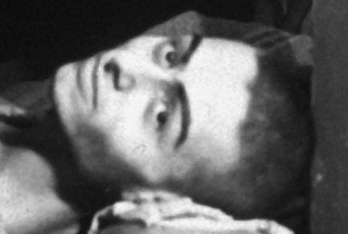
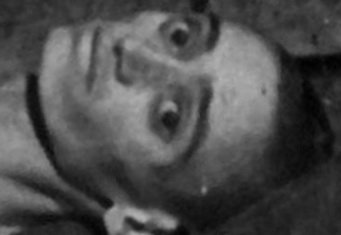
Now look at the young man in the same position in the bottom row, 4th from the left. He is the same man! (close-up on right, above, designated ‘Copy’) The food bowl has been removed from underneath his head, leaving it to a military intelligence photo-retoucher to redo his throat and neck, but in a very un-anatomical manner. Have you ever seen a neck that looked like that? I have not. In an attempt to retain a lesser portion of the ‘gown’ he was wearing so that it would not look the same as the ‘original,’ more bare skin is left showing, but without any anatomical correctness whatsoever.
The retoucher was not a trained artist and was in over his/her head with this assignment. For example, look at the ear. It consists of a few strokes of light-colored paint in an attempt to make something resembling an ear, but failing. Ears are one of the most difficult parts of the body to draw or paint in a convincing manner, but it was necessary to add an ear to this ‘copy’ because the ear is not showing on the original man in the bunk above; it is buried against the upside-down food bowl and some material that’s covering it. The botched ear of the ‘copy’ is one of the biggest giveaways of fakery in this photo, but not the only one.
What’s with all these thick, black eyebrows?
Let’s look at the eyes and eyebrows next. The man whom we are calling “the original,” has very dark, thick eyebrows but otherwise looks normal. The shadow under his chin is probably what was actually there – bringing attention to the fact that a very bright light source in a dark room was shining on the men, and hitting the lower two rows of bunks more than the upper two rows. His “copy” also has very dark, flat eyebrows but they have been redrawn to begin higher up from the bridge of the nose and extend down to the outside corner of the eye, giving him a wild look. Adding to this wild-eyed look is the delineation of more distinct eyelids, rounding the eyes and enlarging the irises, all of which create the zombie look which the ‘original’ doesn’t have.
A couple more things were done in a futile effort to camouflage this ‘copy’: the rounding of the forehead, head, and hairline, and the squaring of the chin and lower jaw. A crude line of black paint, applied all the way up to the big, white ‘cauliflower’ ear, was evidently thought to suffice for a shadow under chin and jaw. Look closely especially where it meets the ear and you can recognize it is paint.
Yet, the nose, mouth, upper jaw and facial shadows remain exactly the same in both figures. The result is a grotesque second person that I suppose has been eliciting sympathy from clueless viewers all these years.
This grotesque, over-worked ‘copy’ is also smaller than it should be for the bunk it occupies – actually being the same size as the man peering out from the next bunk further down. Maybe the forgers thought this would make him look like a young boy. If so, they failed to realize that boys don’t have tiny heads! Now, this peering man has clearly had his eyebrows and eyes emphasized with black paint or pencil. Or he may be totally fake. Others whose eyebrows were treated similarly are: The “elie wiesel” face has heavily emphasized eyebrows; also the second and third man in the third row, and all the men in the top row. I believe the best explanation for this phenomenon is this: the poorly painted eyebrows of the ‘copy’ would stand out too much from the natural-looking eyebrows of all the rest, so it was decided to give a swipe of black paint to many other eyebrows also, including our ‘original.’
As a practicing artist most of my life, from childhood on, who has drawn and painted hundreds of faces and done many portraits, I know quite well how to touch up faces and how tiny adjustments can make a big difference in attaining a likeness. The assignment here was to do the opposite of attaining a likeness; it was to take a photographic carbon copy and make it look unlike the original. If I had done the work on this photograph it would be far superior to the image we have, which is a really sloppy job by people who are not artists and therefore don’t have “an eye” for how things actually look and/or don’t know how to make it look that way. Which is a good thing for us!
NEW ENLARGED IMAGES! In these close-ups showing more of the neck and the space around the faces. we can see more clearly how the head of the “copy” in the lower bunk is angled back, just slightly, since he is lying with his head directly on the floor of the bunk, not propped up as is the “original.” I think it’s likely that after altering the face and hair, and adding an “ear,” the forgers severed the face/head at the jawline and proceeded to paint a brand new neck that would fit the newly angled face with the slightly raised chin. This is why everything below the chin is so horribly wrong. We can see a collar bone and shoulder in the ‘original,’ but there is no bone structure at all in the ‘copy.’ The crude black line representing a shadow under the chin serves to “attach” the two parts together.
The ‘copy’ also has far less contrast, is overall grayish, which would happen from all the retouching, or also that this copy was set for low contrast. We can see that the shadows on the side of the face follow the same pattern even though they’ve been interrupted here and there. We can also see clearly how the upper line of the face was indented right below the cheekbone, and was added to along the mouth area. The line of the mouth between the upper and lower lips goes all the way to the edge of the face, but on the ‘copy’ it stops short of the edge. You can see the gray paint added at that upper corner of the mouth.
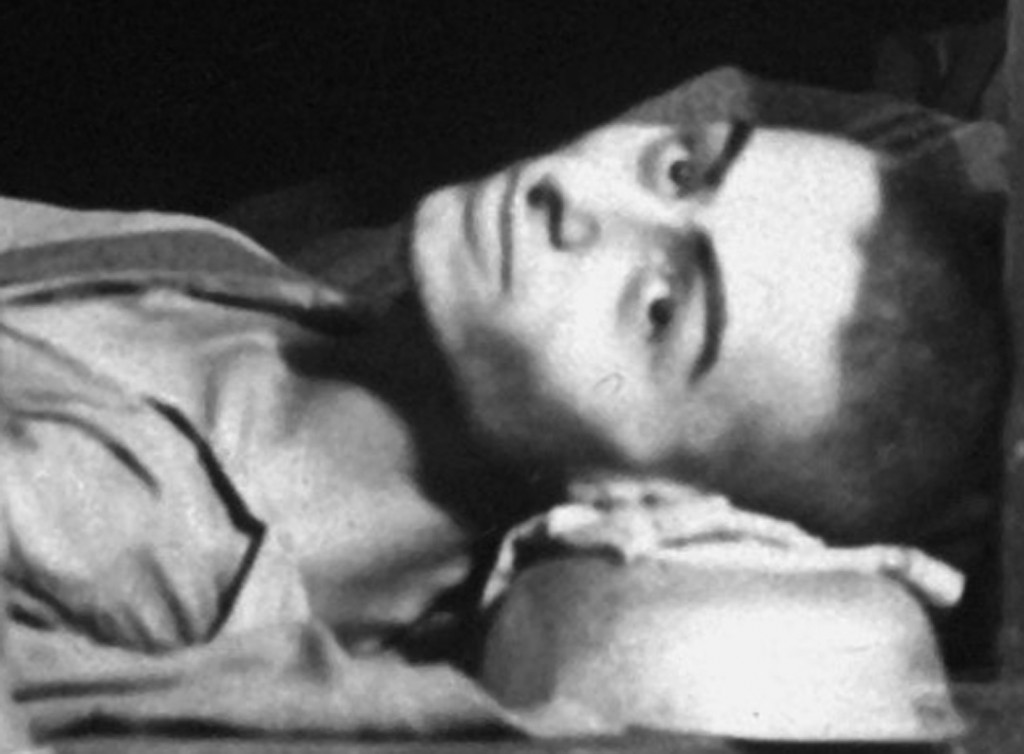
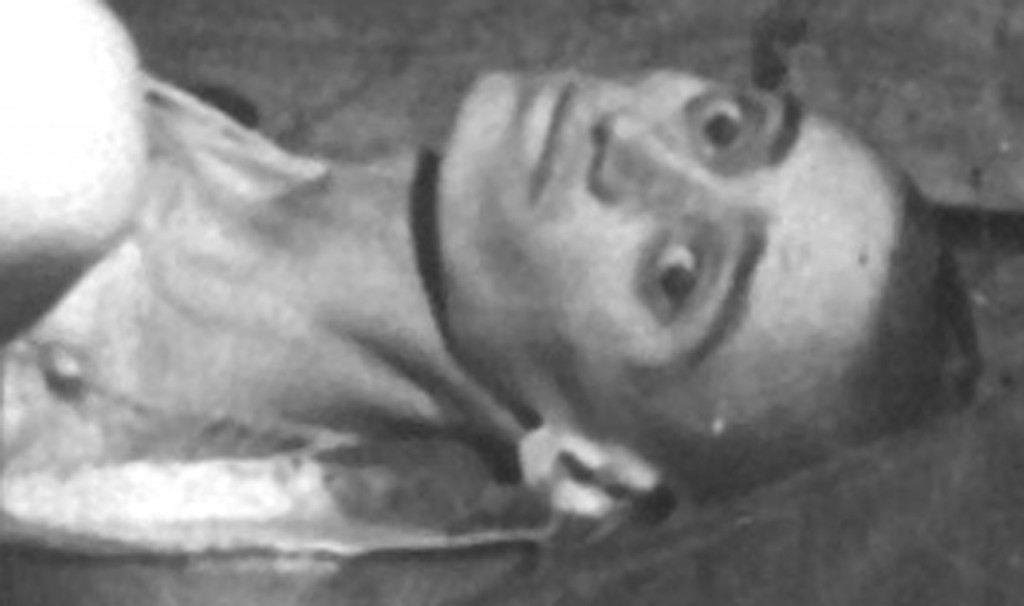
Hundreds of forged and mislabeled photographs make up the “Holocaust”
This is one photograph out of many that were also forged. I believe it is one of the most important because it has been given such a prominent place among the documents “proving” the “Holocaust.” Elie Wiesel, or his handlers, no doubt selected this photo – from many possible others wherein he could be falsely identified as one of the crowd – because it was already so well-known and was in many books and publications. Therefore, whenever it is published somewhere, it can be said that Nobel Prize winner Elie Wiesel is in the picture. However, they didn’t count on it being exposed as a fraud – they never do. But now it has been, and it’s up to us – all of you reading this – to see that the exposé becomes known everywhere this photograph appears. This is what it will take to break the spell.
What we have to fight against – our own people
A fellow revisionist who helps me with technical issues from time to time for this blog actually wanted me to hold back on this because he could not be sure that the two figures discussed in this article are the same man! What would it take to convince him? A confession from the perpetrators? A corroboration from an authority figure or a Jew? Why the difficulty in contradicting the given narrative?
A poster at Stormfront who boldly calls himself “The Hammer of God” had this to say when confronted with the empty black area in the NYTimes reprint:
Idk, newspapers did have pretty low-quality pictures at that time, so maybe that whole area was just set to black, but it looks bright enough for that person to have shown up. The lighting actually seems a bit brighter on that man, which makes it even stranger why that section would appear black. So, perhaps it is a forgery, but I can’t say for certain.
People like ‘The Hammer” should spend more time studying how the magic spell works. It works like this: Evidence doesn’t count; don’t trust it; don’t trust your own brain; trust the consensus. Far too many of us cannot break out of the consensus about the “Holocaust” and the ” evil Nazis.” For this reason, we need to clearly understand what is being done, and how it’s being done. The “how” is very important. It’s a kind of sleight of hand, a magic act, and we are the ones being both entertained and kept in servitude by it. Understanding this is how we will break the spell.
7 Comments
Category Featured | Tags: Tags: Elie Wiesel, fakery, famous Buchenwald photo, Holocaust, magic, photo retouching, trickery,
Social Networks: Facebook, Twitter, Google Bookmarks, del.icio.us, StumbleUpon, Digg, Reddit, Posterous.
Wednesday, December 19th, 2012
By Carolyn Yeager
copyright 2012 carolyn yeager

This is the photograph that Allied Supreme Commander General Dwight David Eisenhower ordered, in April 1945, to be posted in every German town and city 1 to show the defeated population the “true meaning of Nazism.”
Was this photo made to order according to Ike’s specifications?
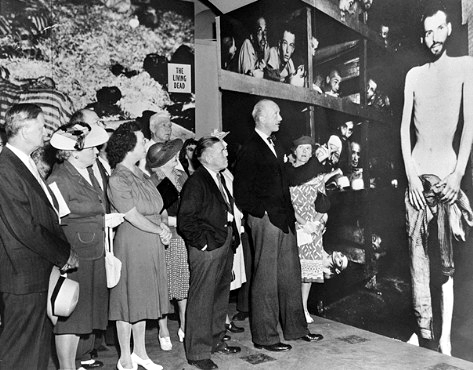 A huge blown-up version then went on tour in the United States for the same purpose, to impress on the American people what evil they had gone to war against; why the sacrifice of blood and treasure was justified! Left: “A traveling exhibit of larger than life size photographs was first shown in St. Louis, MO in summer 1945 and then taken to Washington, DC.
A huge blown-up version then went on tour in the United States for the same purpose, to impress on the American people what evil they had gone to war against; why the sacrifice of blood and treasure was justified! Left: “A traveling exhibit of larger than life size photographs was first shown in St. Louis, MO in summer 1945 and then taken to Washington, DC.
It was plastered on the front pages of newspapers across the country. Thus it became one of the most iconic images representing WWII and of what later came to be known as “The Holocaust.” The intention was to portray the war as a noble effort to “save the Jews from enslavement and extermination,” just as the equally bloody American Civil War had come to be taught as a war “to free the slaves,” i.e. the Negroes who were not citizens of the country they were living in.
Both are black propaganda campaigns that still use whatever is at hand, whether it be subterfuge or not.
In the case of the above photograph, we have learned that the standing figure, the part that makes the biggest, most memorable impact on the viewer, was added later – it was not in the original photo allegedly taken by Private H. Miller of the Civil Affairs Branch of the U.S. Army Signal Corps on April 16, 1945, five days after the “liberation” of the Buchenwald Concentration Camp by American forces.
A blogger, the owner of the Winston Smith Ministry of Truth website who goes by the nickname Black Rabbit, decided a week or so ago, out of curiosity, to order the New York Times newspaper article from May 6, 1945 in which this photo was published, and when it came the photo looked like this:
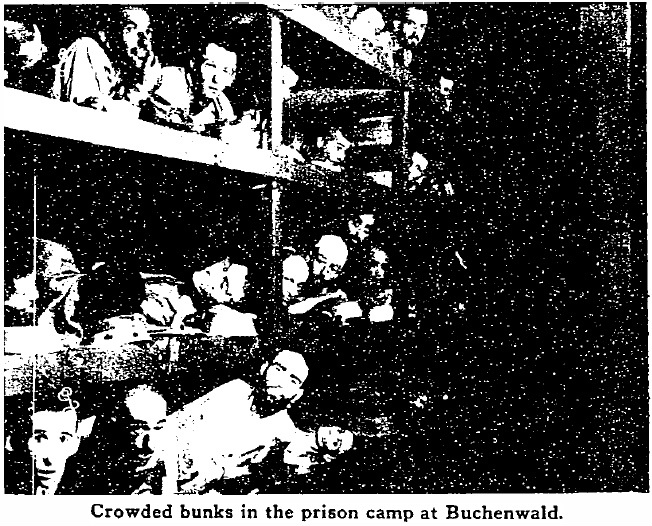
Here is page 2 and 3 of the New York Times article (click to show entire page):
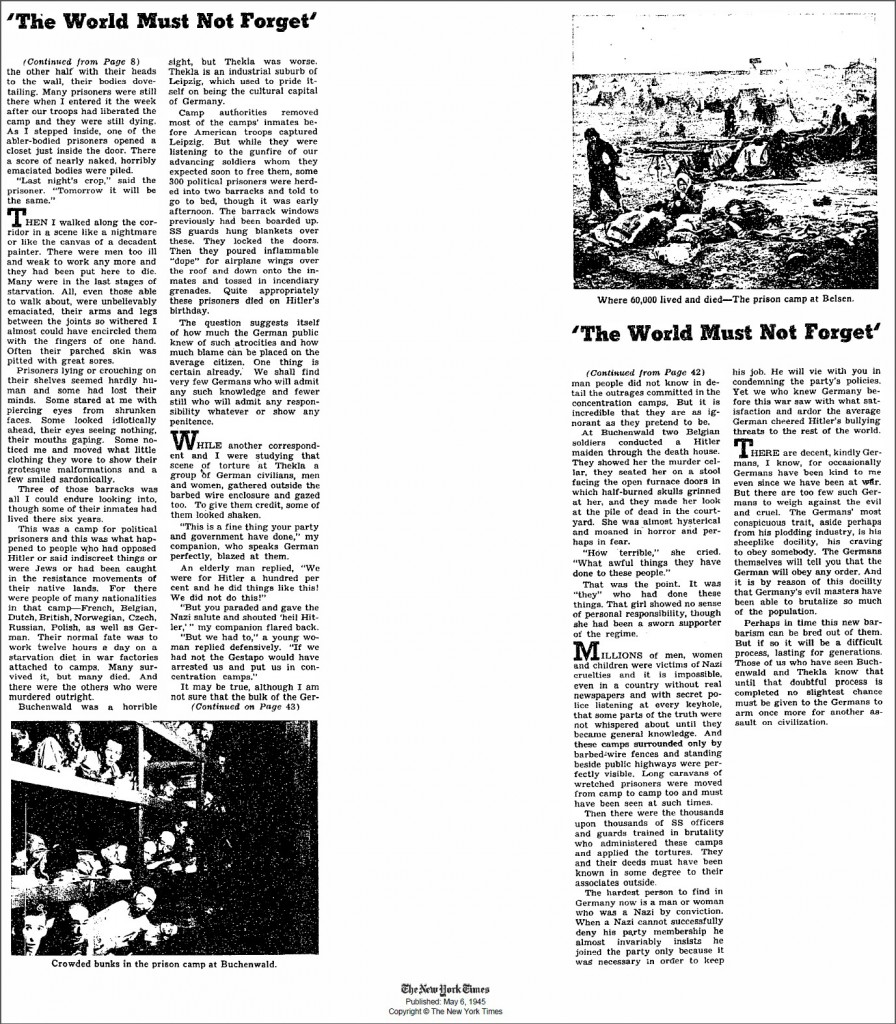
What a shock to see only an empty dark space, and in the New York Times no less!
What happened to the standing man? I was the first to bring it to the attention of the participants in the comment section of furtherglory’s Scrapbookpages Blog after Black Rabbit posted a link to the original article there, and then we quickly began noticing the tell-tale signs of FORGERY about this strange figure who had always appeared odd to me standing there naked as he is, but did not arouse enough suspicion amidst all of the onslaught of “holocaust” imagery, stories and news articles with which we are constantly being bombarded. We see what we are supposed to see, what we’re told we’re seeing, and almost always leave it at that. It is also one of the better photo-forgery jobs of Allied holocaust black propaganda – could that be because it was being done at the behest of the Supreme Commander himself?
But let me point out some problems with this figure:
- His position in relation to the post is an impossible one (see top photo; click once on image and then again for full enlargement). He is not leaning against the post, but neither is he standing in front of the post. His feet are in line with the base of the post, but his left shoulder and arm are in front of the post – without any shadow of any kind. There is something ghostly about this figure, as though he’s an apparition.
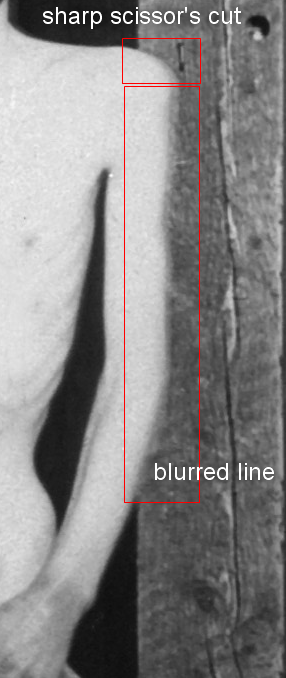 The edge of his left arm is fuzzy, as if it is drawn or painted where it meets the post (detail right). The rest of the outline of his shoulders and arms is very sharp, as though cut with scissors. [In most large-scale reproductions of this photo we have seen (as shown on the Winston Smith Blog), the left edge of the arm is cropped because the larger the image the more noticeable it is.
The edge of his left arm is fuzzy, as if it is drawn or painted where it meets the post (detail right). The rest of the outline of his shoulders and arms is very sharp, as though cut with scissors. [In most large-scale reproductions of this photo we have seen (as shown on the Winston Smith Blog), the left edge of the arm is cropped because the larger the image the more noticeable it is.- Notice the blinding whiteness of his torso, and how different it is from his face, hands and legs which are darker (top photo again). The more one studies the torso and arms, the more they look like a drawing rather than a photograph. Notice how faint are the nipples and definition on his chest compared to the man in the lower bunk who is pushing himself forward the better to be seen.
- Notice the relaxed, almost dreamy expression on the face of the standing man (detail below): his lips are parted in a smile; his eyes are looking off into the distance, not at the photographer. He appears in an untroubled state of mind, unsuited to the environment he’s in and unlike the other men .

- 5. A light source seems to be coming from above right as we face the photo, but the shadows on the legs and feet suggest a light source directly from above. Also, the angle of the shadows on the floor made by the post and by the right leg of the standing figure are not aligned.
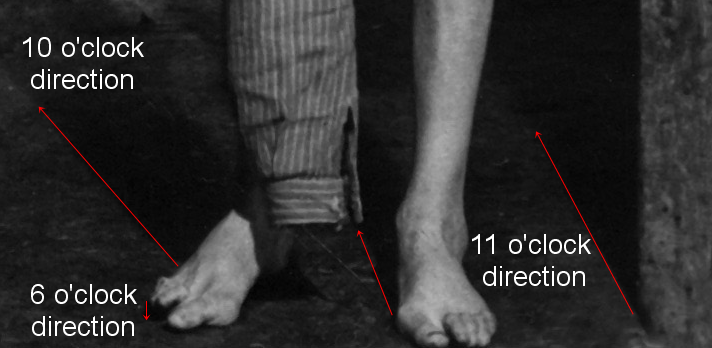
6. Ask yourself why he would be standing there completely nude, with that unlikely expression on his face, five days after the liberation? Also ask yourself why these men would still be lying in these bunks fully dressed, though some having taken their shirts off for effect, five days after the liberation? The only answer is that it’s a staged, arranged photo-shoot for propaganda purposes, not an impromptu entry by a photographer right at the time of liberation – as we are led to believe (because we are supposed to believe it) by the captions that accompany the photo. For example, in the Moberly (Missouri) Monitor-Index on April 30, 1945, the caption to this photo reads: “Slave laborers in their crowded rough bunks in the Buchenwald concentration camp near Jena, Germany, as they were found when U.S. troops of the 80th Division entered the camp.”
Fakery such as this is common in war propaganda; it just usually doesn’t last so long
We not only have the NYT newspaper article showing the photograph without the standing man, but we can also point out tell-tale signs that this figure was added to the photo … and that it was itself doctored to show a very skinny torso of a “starving” man. What deceit! If Eisenhower propaganda specialists had really found such scenes, they would not have had to invent them!
And yes, I’m asking how many personnel were aware, had to be aware, of this type of forgery. And some still living who are still perfectly aware that “The Holocaust” was and is a post-war intelligence operation with no holds barred. For example, so many of the photos that are archived and sold to the gullible public by the propaganda mill that goes by the name of the United States Holocaust Memorial Museum (USHMM) (using your tax dollars) are wildly mislabeled. The USHMM identifies this very photograph as follows:
Former prisoners of the “little camp” in Buchenwald stare out from the wooden bunks in which they slept three to a “bed.” [Photograph #74607]
Elie Wiesel is pictured in the second row of bunks, seventh from the left, next to the vertical beam.
The man in the bottom left hand corner has been identified as Michael Nikolas Gruner, originally from Hungary, Gershon Blonder Kleinman or Yosef Reich. Isaac Reich is in the bottom row, second from the right and Max Hamburger is on the bottom row, fourth from the left. Perry Shulman from Klimitov, Poland is on the top bunk, second from the left (looking up). The man in the second row, third from left has been identified as Dawid Najman. The man in the second row, fourth from the left has been identified as Abraham Hipler; Berek Rosencajg from Lodz or Zoltan Gergely from Cluj. The man on the third bunk from the bottom, third from the left, has been identified as Ignacz (Isaac) Berkovicz, Abraham Baruch and Paul Argiewicz . Juraj (now Naftali) Furst is pictured in the third bunk, fifth from the left. Standing on the right is Chaim David Halberstam.
Others say the standing man is Simon Toncman, who after the ‘Liberation’ returned to his home country The Netherlands, started a family and became a successful businessman. He refused to talk about this photo until the day he died. 2 (Why would that be? Because he knew it was a fake! And because he had been told to keep quiet about it. That’s the best, and only reasonable explanation.)
Of the identified men, one is definitely mis-identified! — and that is Paul Argiewicz. The real Paul Argiewicz was discovered by furtherglory; I picked up his work here (scrowl down to the German drivers license). How could the “Jewish Organizations” with access to Bad Arolson get that so wrong? They all do it all the time. For example, the ‘meantime -Allen Hall” article says that “Red Cross records show Heiman Leefsma survived Barrack 56 as a 20-year-old.” Yet when we see who he is identified as in the Flicker picture, he has a balding head and looks like the oldest man there.
And then there is Elie Wiesel! Please see especially here for proof that the man in the bunk is NOT Elie Wiesel. So that is more fakery surrounding this photo, but in this case the person was really in the original photograph, but is an unknown person. The decision to call that man Elie Wiesel was only made around 1983, with a Nobel Prize in mind.
Both the USHMM and the Allan Hall article are full of errors. There is no need for holocaust “historians,” filmmakers, or “researchers” to be concerned about accuracy — it doesn’t matter how iconic or world-famous they are. Sloppiness goes unpunished, especially since so much of it is on purpose — to deceive and keep the myth going. I will be posting about some other fraudulent pictures from Buchenwald in the future.
End Notes:
1. “US army commander General Dwight Eisenhower ordered this picture to be posted in every German town and city to show the defeated population the true meaning of Nazism,” writes Allan Hall. http://www.meantime.com.au/mean-time-articles/2008/8/12/60-years-on-the-faces-of-nazi-shame-get-their-names-back/
2. Same source (meantime.com): Quote – “Now, 63 years after they were liberated, they have been united again in print by a German newspaper granted rare access to the files of the Red Cross Tracing Service at Bad Arolsen, Germany.
Using the original German SS registration cards and the camp’s “Todesbuch” – book of death – researchers were able to match up names with Jewish organisations around the globe.
Paul Argiewicz, 82, is now living in the US. He lost his parents in the gas chambers and is a regular on American TV shows talking about his experiences.
Red Cross records show Heiman Leefsma survived Barrack 56 as a 20-year-old. A Dutch national, he vanished shortly after liberation and inmate 130305 has not been heard from since.
Nikolas Gruener, now 80, is a Hungarian Jew who was suffering from TB at the time of liberation. “We warmed ourselves on the bodies of the dead before they cooled down,” he said. A successful businessman after the war, he took part in a number of interviews recently for director Steven Spielberg’s Holocaust archive. He lost his parents and two brothers in the camps.
Max Hamburger is now 88. He was active in the resistance in Amsterdam. He survived the death factory of Auschwitz because he was employed as a medic and went on to Buchenwald, where he weighed just 19 kilograms at liberation. After the war he settled in Belgium,where he became a psychiatrist. He speaks regularly to universities about the Holocaust and his experiences.
Nobel Prize winner Elie Wiesel is one of the most well-known Holocaust survivors. Wiesel, who coined the phrase “never again”, is now 79. He was awarded the peace prize in 1986. “That is me,” he said, when shown the photo in the 1960s.
Simon Toncman, a Dutch Jew, was 28 at the time of liberation. He married a survivor from Auschwitz and went on to have a successful career in accountancy in his homeland before dying from a genetic bowel complaint in 1975. He never spoke about his Holocaust experiences but revelled in his “wonderful family life”. He had nine grandchildren before his death.
Mel Mermelstein, 81, is a Hungarian Jew whose whole family perished in Auschwitz. He was portrayed by Leonard Nimoy in a 1991 movie called Never Forget, about his lawsuit against Holocaust deniers in America who suggested the gas chambers were a myth. His autobiography is called By Bread Alone and he too speaks regularly about his time in the camps. Of the photo, he said: “We were alumni of some of the most terrible places on earth. This picture and the men in it mean more to me than I can say.”
26 Comments
Category Featured | Tags: Tags: Elie Wiesel, famous Buchenwald photo, forgery, General Dwight Eisenhower, New York Times, Paul Argiewicz, photo-fakery, Scrapbookpages Blog, Simon Toncman, USHMM, war propaganda, Winston Smith Ministry of Truth,
Social Networks: Facebook, Twitter, Google Bookmarks, del.icio.us, StumbleUpon, Digg, Reddit, Posterous.
Tuesday, April 17th, 2012
A Swedish reader has informed this website of a new computer program that gives the approximate age of a person by scanning their photograph. Scroll down the linked page to see six examples. [Unfortunately, as of 12-5-15 this page is no longer online, at least not at the address it was. But I found two write-ups about it here and here. It does exist.]
Our reader took advantage of the website’s free demonstration offer and tested two faces from the famous Buchenwald liberation photo taken on April 16, 1945. Nikolaus Grüner is in the lower left of the FBLPhoto, and in the background is the round-headed man who is claimed to be Elie Wiesel. These are the results the computer program gave him.
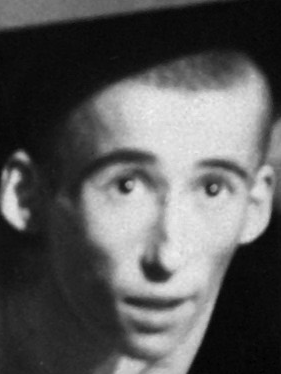
Above: Estimated age 16 years (exactly the age Grüner was at the time)
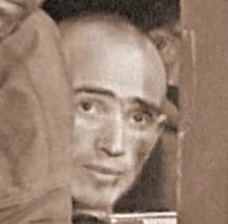
Above: Estimated age between 30 and 36 years (Elie Wiesel was only 16 at the time)
This does not surprise us. It fits what we can see with our natural eyes and brain — and what other evidence has told us. But it’s nice to know that a program designed by the bright folks at Apple has confirmed it.
6 Comments
Category Featured | Tags: Tags: Elie Wiesel, famous Buchenwald photo, Nikolaus Grüner,
Social Networks: Facebook, Twitter, Google Bookmarks, del.icio.us, StumbleUpon, Digg, Reddit, Posterous.
Saturday, November 26th, 2011
by Carolyn Yeager
copyright 2011 carolyn yeager
Accepts Yad Vashem propaganda book as good enough to go by.
According to a letter (see below) received by a German reader of this website from Sabine Stein of the Gedenkstatte Buchenwald (Wiemar, Germany), the Buchenwald Memorial’s acceptance that Elie Wiesel is one of the men in the famous Buchenwald Liberation photograph is based on the reliability of Yizhak Arad’s The Pictorial History of the Holocaust. This book was published several years after the New York Times announced to the world that Elie Wiesel was in the picture, and the U.S. Holocaust Museum went along with it. There has never been any real, or convincing, verification that the man in the picture is Elie Wiesel.
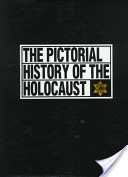 Originally published in 1990, The Pictorial History of the Holocaust was edited by Yizhak Arad; designed by Hava Mordohovich, published by the Yad Vashem Holocaust Martyrs’ and Heroes’ Remembrance Authority in Jerusalem. It says on the copyright page: The publication of this album was made possible through the initiative and generosity of Miriam and Haim Schaechter. The Editorial Board is composed of Yizhak Arad, Reuven Dafni, Gideon Greif and Yehudit Levin. Maps drawn by Alissa Gold. The book is a 100% Jewish-Israeli production (note the Star of David on the cover) and is partisan propaganda.
Originally published in 1990, The Pictorial History of the Holocaust was edited by Yizhak Arad; designed by Hava Mordohovich, published by the Yad Vashem Holocaust Martyrs’ and Heroes’ Remembrance Authority in Jerusalem. It says on the copyright page: The publication of this album was made possible through the initiative and generosity of Miriam and Haim Schaechter. The Editorial Board is composed of Yizhak Arad, Reuven Dafni, Gideon Greif and Yehudit Levin. Maps drawn by Alissa Gold. The book is a 100% Jewish-Israeli production (note the Star of David on the cover) and is partisan propaganda.
But the Buchenwald Memorial outside of Weimar has nothing better to point to as why we should believe that Elie Wiesel was one of their famous “guests.” This book captions the picture in question as: “Elie Wiesel, Nobel Peace Prize winner 1986, is the farthest right on the second tier from below.” Interesting that they add Nobel Peace Prize winner, isn’t it? That was the whole purpose of claiming Elie to be in the picture to begin with.
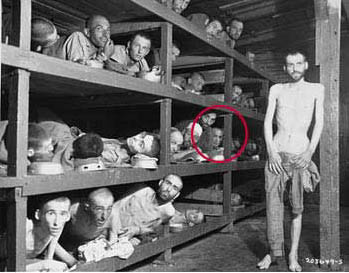 Sabine also admits that Simon Toncman (standing, who never identified himself in the picture) was identified by his internee number, while all others who are supposedly known to be in the picture recognized, i.e. identified, themselves. That means Elie Wiesel is self-identified, as is Myklos Grüner.
Sabine also admits that Simon Toncman (standing, who never identified himself in the picture) was identified by his internee number, while all others who are supposedly known to be in the picture recognized, i.e. identified, themselves. That means Elie Wiesel is self-identified, as is Myklos Grüner.
To put a better face on this, Ms. Stein tells the letter-writer about the questionnaire of 22 April 1945. But as we know, this questionnaire was filled out for Lázár Wiesel with a birthdate of Oct. 4, 1928, not Sept. 30 which is Elie’s birthdate, and the hand-written signature on the questionnaire doesn’t match Elie’s later known signature. The Buchenwald ID number given to this Lázár Wiesel is 123165, which had formerly belonged to a Pavel Kun who died on 8th March ’45 (one month earlier!) That means it could not have been given to Elie Wiesel when he arrived and was registered at the end of January ’45. Why would young Elie Wiesel be given, in April, a new ID number that had belonged to a recently deceased inmate? And at the same time be given a new birthdate? With all these problems, this questionnaire is still used, along with the photograph, to “prove” Wiesel was detained in Buchenwald. I conclude that the Memorial Museum is only going along with these weak pieces of “evidence” because it is itself part of the “holocaust” business. We must remember that the Buchenwald Memorial was the creation of ex-inmates, mostly communists, who had. and still have, a vested interest in promoting the worst possible view of the National Socialist Germans. No exaggeration or lie was too great for them to enshrine as truth. The organization these ex-inmates formed still runs the Buchenwald Memorial site today.
All deceased internees names not known
Ms. Stein further tells our reader that her department cannot determine the names of all deceased internees of the KZ Buchenwald because at the beginning of 1945 arrivals died before their personal datas could be registered. However, the day and location of death was registered as “unknown deaths.” (We know that Shlomo Wiesel could not be one of these “unknown deaths” because his death, according to son Elie’s books, took place over a week after arrival. In addition, others in the transport Elie and Shlomo are said to have been on were registered.) According to Stein, there were a total 1265 of these deaths between Jan. 1 and April 11, 1945 and just who they are will be determined at a future time when the Bad Arolson archives are made available to them. (Can it be that the Arolson archives are open to Ken Waltzer of Michigan State University Jewish Studies Dept. but not to the Archive Dept. of the Buchenwald Memorial Museum? Strange stuff.)
Therefore, Sabine Stein says a complete list of the names of the liberated internees of the KZ Buchenwald, who were present at Buchenwald on April 16, 1945, is not available from her. In other words, she cannot clear up the mystery of Elie Wiesel, she can just go along with the narrative as it is and not make waves.
******
The letter from Sabine Stein to our reader, with personal information removed, is translated below into English.
07 09 11
Dear Mr. ______,
Please find the enclosed answer of your questions as per our previous notice.
Permit me some remarks concerning the general position of the memorial regarding its archive and documents.
The Archive of the memorial does not posses the original registration of the KZ Buchenwald, nor the original documents of the closing of the camp after its liberation in April 1945. Those documents are stored at the International Search Service of the Red Cross at Bad Arolsen (www.its-arolsen.org). The basis of our research is a biographical collection of individual persons and comprehensive reports for our archive. We started in 1971; for historical reasons it is therefore forced to be incomplete. In order to arrive at dependable results, additional relevant collections and archives have to be gained, specifically in regard to internees who were transferred to different national socialist concentration or destruction camps.
1) Photo 020-46007
With exception of Simon Toncman who was identified by his internees number, all other named persons recognized themselves. Elie Wiesel’s identification was based on the publication of Yizhak Arad’s The Pictorial History of the Holocaust, Maxwell Macmillan International 1992. On page 403 is the photo and on page 404 the following text appears: Buchenwald, after the liberation, survivors in their barracks. Elie Wiesel, Nobel Peace Prize winner 1986, is the farthest right on the second tier from below.
2) Regarding the liberated person Elie Wiesel, there exists a questionnaire on microfilm for inmates of the concentration camp 22nd of April 1945, (BwA 51-11-842). The original is at the aforementioned ITS (International Tracing Service) Arolsen.
When counting the dead internees based on the camp statistics, you made an error. According to documents of the camp office, official death is registered for the time span 1.1.1945 to 31.3 1945. (Jan. 1 to March 31—3 months -cy) During that time 13.910 internees died.
From 1.4.1945 until 11.4.1945, 913 internees died. (April 1 to April 11—10 or 11 days) This amounts (from 1.1 to 11.4 1945), to a total of 13,966 and not 13,969. (These figures don’t add up, but I double-checked them and this is what the original letter in German said.)
Throughout years of research we tried our best to determine the names of all deceased internees of the KZ Buchenwald. Yet at the beginning of 1945 arrivals died before their personal datas could be registered, in that case the statistics of the camp register them as “unknown” death. All those not-named deaths are registered at the data bank as “unknown death,” by day of death and location of death. For the time of January till April 1945 a total of 1265. Because the archive of the international search institute at Bad Arolsen unfortunately remained closed for us, the files available there are not yet worked into our memorial book. This will be done in the near future. A complete list with the names of the liberated internees of the KZ Buchenwald or the persons present at Buchenwald on 16.4.1945 is unfortunately not available. Further information might be found at the National Archive at Washington.
Of the 5 Buchenwald internees numbers, I can only name the one of Miklos Gruener (Michael Nikolas Gruener), 120762. The one of Wiesel, 123165, you know already. The other numbers I could not find because the number card is not handed down (or complete). Only ITS Arolsen can also help here.
Friendly Greetings
Sabine Stein/Archive
7 Comments
Category Featured | Tags: Tags: Buchenwald, Elie Wiesel, famous Buchenwald photo, ITS-Bad Arolsen, Sabine Stein, The Pictorial History of the Holocaust, Yad Vashem, Yizhak Arad,
Social Networks: Facebook, Twitter, Google Bookmarks, del.icio.us, StumbleUpon, Digg, Reddit, Posterous.

























